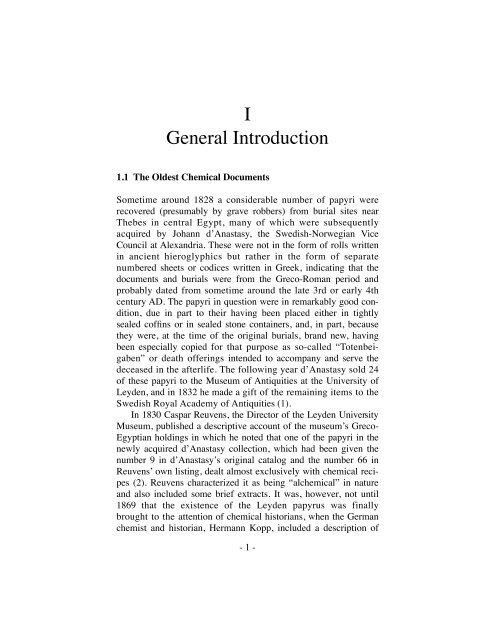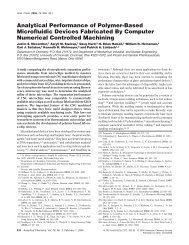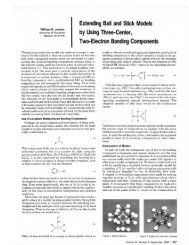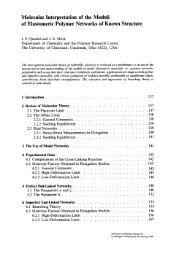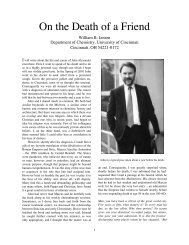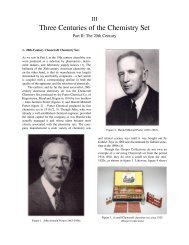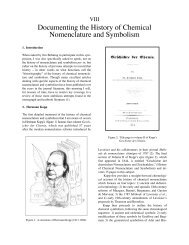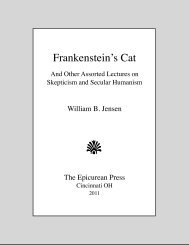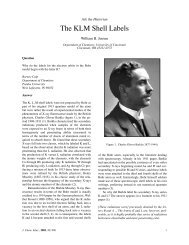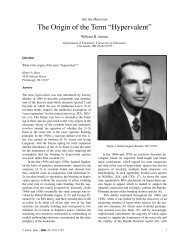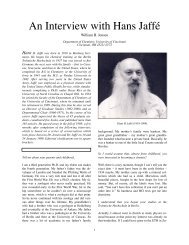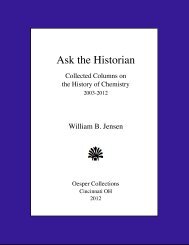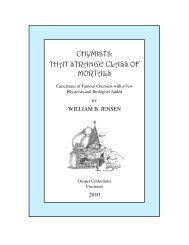The Leyden and Stockholm Papyri - University of Cincinnati
The Leyden and Stockholm Papyri - University of Cincinnati
The Leyden and Stockholm Papyri - University of Cincinnati
Create successful ePaper yourself
Turn your PDF publications into a flip-book with our unique Google optimized e-Paper software.
I<br />
General Introduction<br />
1.1 <strong>The</strong> Oldest Chemical Documents<br />
Sometime around 1828 a considerable number <strong>of</strong> papyri were<br />
recovered (presumably by grave robbers) from burial sites near<br />
<strong>The</strong>bes in central Egypt, many <strong>of</strong> which were subsequently<br />
acquired by Johann d’Anastasy, the Swedish-Norwegian Vice<br />
Council at Alex<strong>and</strong>ria. <strong>The</strong>se were not in the form <strong>of</strong> rolls written<br />
in ancient hieroglyphics but rather in the form <strong>of</strong> separate<br />
numbered sheets or codices written in Greek, indicating that the<br />
documents <strong>and</strong> burials were from the Greco-Roman period <strong>and</strong><br />
probably dated from sometime around the late 3rd or early 4th<br />
century AD. <strong>The</strong> papyri in question were in remarkably good condition,<br />
due in part to their having been placed either in tightly<br />
sealed c<strong>of</strong>fins or in sealed stone containers, <strong>and</strong>, in part, because<br />
they were, at the time <strong>of</strong> the original burials, br<strong>and</strong> new, having<br />
been especially copied for that purpose as so-called “Totenbeigaben”<br />
or death <strong>of</strong>ferings intended to accompany <strong>and</strong> serve the<br />
deceased in the afterlife. <strong>The</strong> following year d’Anastasy sold 24<br />
<strong>of</strong> these papyri to the Museum <strong>of</strong> Antiquities at the <strong>University</strong> <strong>of</strong><br />
<strong>Leyden</strong>, <strong>and</strong> in 1832 he made a gift <strong>of</strong> the remaining items to the<br />
Swedish Royal Academy <strong>of</strong> Antiquities (1).<br />
! In 1830 Caspar Reuvens, the Director <strong>of</strong> the <strong>Leyden</strong> <strong>University</strong><br />
Museum, published a descriptive account <strong>of</strong> the museum’s Greco-<br />
Egyptian holdings in which he noted that one <strong>of</strong> the papyri in the<br />
newly acquired d’Anastasy collection, which had been given the<br />
number 9 in d’Anastasy’s original catalog <strong>and</strong> the number 66 in<br />
Reuvens’ own listing, dealt almost exclusively with chemical recipes<br />
(2). Reuvens characterized it as being “alchemical” in nature<br />
<strong>and</strong> also included some brief extracts. It was, however, not until<br />
1869 that the existence <strong>of</strong> the <strong>Leyden</strong> papyrus was finally<br />
brought to the attention <strong>of</strong> chemical historians, when the German<br />
chemist <strong>and</strong> historian, Hermann Kopp, included a description <strong>of</strong><br />
- 1 -


